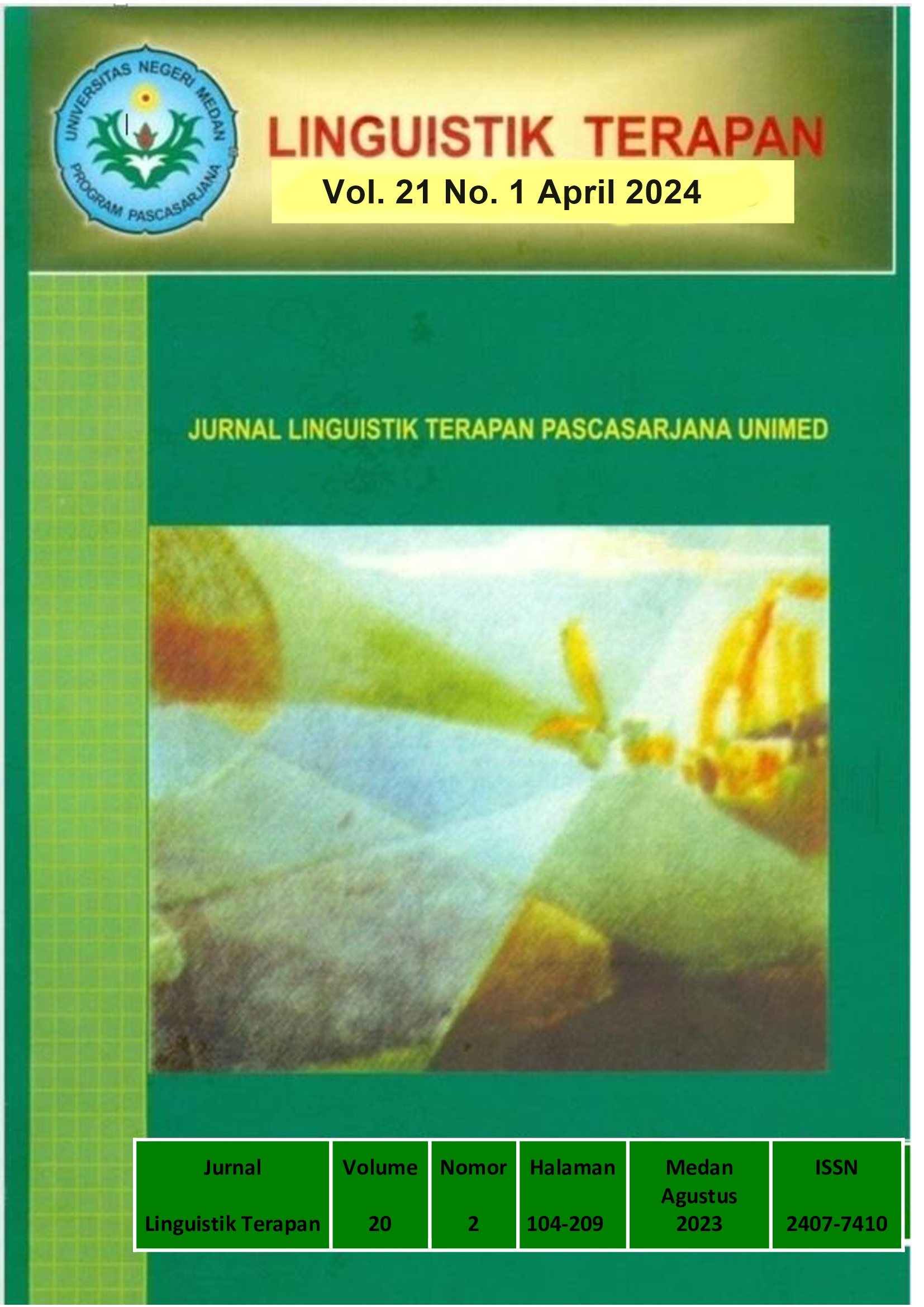Using Chatgpt for Translating Songs Between Bahasa Indonesia and English
DOI:
https://doi.org/10.24114/lt.v21i1.64876Keywords:
Artificial Intelligence (AI), ChatGPT, translation, cultural Adaptation, contextual accuracyAbstract
As a first-year PhD student, I was inspired by my lecturers to embark on this research to explore self translation with the aid of AI, specifically ChatGPT by OpenAI. This study investigates the potential benefits and challenges of using AI to translate Christian praise and worship songs between Bahasa Indonesia and English. By focusing on linguistic accuracy, cultural adaptation, and artistic integrity, using a qualitative case study approach, I evaluated the efficacy of ChatGPT in enhancing the quality and efficiency of self translation in worship music. My research involved translating five songs—two from English to Indonesian, two from Indonesian to English, and one from Batak to English—using an iterative process that combined ChatGPT's outputs with Google Translate and human expertise. The findings reveal that while ChatGPT can effectively bridge linguistic gaps and maintain the original compositions' integrity, human involvement remains crucial for ensuring linguistic, cultural, and contextual accuracy. This study underscores the potential of AI as a valuable tool in the self-translation of worship songs, highlighting the importance of human-AI collaboration.References
Brown, T. B., Mann, B., Ryder, N., Subbiah, M., Kaplan, J., Dhariwal, P., ... & Amodei, D. (2020). Language models are few-shot learners. Advances in Neural Information Processing Systems, 33, 1877-1901.
Dabre, R., Chu, C., & Kurohashi, S. (2019). Exploiting multilingualism through multistage fine-tuning for low-resource neural machine translation. Transactions of the Association for Computational Linguistics, 7, 233-246. https://doi.org/10.1162/tacl_a_00269
Echols, J. (2021). The translation of theological concepts in worship songs: Challenges and strategies. Journal of Religious Translation Studies, 15(1), 45-60.
Franzon, J. (2022). Approximations and appropriations: Making space for song translation in translation studies. In HARTAMA-HEINONEN, RITVA/IVAS-ka, Laura/Kivilehto, Marja/Koponen, MaarIT (Hg.): Electronic Journal of the KäTu Symposium on Translation and Interpreting Studies, 15, 25-41.
Franzon, J., Greenall, A. K., Kvam, S., & Parianou, A. (Eds.). (2021). Song translation: Lyrics in contexts (Vol. 113). Frank & Timme GmbH.
Guerberof Arenas, A. (2020). The role of AI in translating idiomatic expressions and cultural references. Translation Technology Journal, 27(2), 89-103.
Guo, F., Zhang, C., Zhang, Z., He, Q., Zhang, K., Xie, J., & Boyd-Graber, J. (2022). Automatic song translation for tonal languages. arXiv preprint arXiv:2203.13420.
He, H. (2024). Refining tour commentaries translation at Tang Paradise: An application of Peter Newmark’s communicative translation theory. Journal of Social Science Humanities and Literature, 7(1). Retrieved from https://www.adwenpub.com/index.php/jsshl/article/view/211
He, X., Li, L., Li, P., Liu, J., & Peng, H. (2021). Bridging the gap between AI and human translators: The role of prosody in song translation. Journal of Artificial Intelligence Research, 70, 497-515.
Johnson, M., & Zhang, L. (2021). The impact of AI on dynamic equivalence in translation. Journal of Modern Translation Studies, 34(2), 112-128.
Junczys-Dowmunt, M., Grundkiewicz, R., & Dwojak, T. (2019). Microsoft's submission to the WMT2019 news translation task: Exploring new techniques for low-resource and multilingual translation. Proceedings of the Fourth Conference on Machine Translation (WMT), 422-430. https://doi.org/10.18653/v1/W19-5345
Khoshsaligheh, M., Sarvghadi, F., & Lah, S. C. (2023). Song translation: Lyrics in context. Translation & Interpreting, 15(2), 176-179.
Koehn, P., & Knowles, R. (2017). Six challenges for neural machine translation. Proceedings of the First Workshop on Neural Machine Translation, 28-39. https://doi.org/10.18653/v1/W17-3204
Lample, G., Conneau, A., Denoyer, L., & Ranzato, M. A. (2019). Unsupervised machine translation using monolingual corpora only. International Conference on Learning Representations (ICLR).
Lample, G., et al. (2019). Cross-lingual language model pretraining. Advances in Neural Information Processing Systems, 32, 218-230.
Low, P. A. (2017). Translating song: Lyrics and texts. Routledge.
Martínez, L. (2019). Teaching dynamic equivalence: Pedagogical approaches in translation education. Translation Education Journal, 27(1), 45-60.
Matusov, E., Ma, Y., & Roth, R. (2019). Addressing ambiguity in neural machine translation via data augmentation. Proceedings of the 2019 Conference on Empirical Methods in Natural Language Processing (EMNLP), 5854-5860. https://doi.org/10.18653/v1/D19-1596
Newmark, P. (1988). A textbook of translation. Prentice-Hall International.
Nida, E. A. (1964). Toward a science of translating: With special reference to principles and procedures involved in Bible translating. E. J. Brill.
Post, M., Kumar, G., & Haddow, B. (2020). Incorporating BERT into neural machine translation. Proceedings of the 2020 Conference on Empirical Methods in Natural Language Processing: Findings, 999-1005. https://doi.org/10.18653/v1/2020.findings-emnlp.89
Radford, A., Wu, J., Child, R., Luan, D., Amodei, D., & Sutskever, I. (2019). Language models are unsupervised multitask learners. OpenAI.
Sari, I. (2019). Preserving emotional tone in translating worship songs: A case study of Bahasa Indonesia to English translations. Asian Journal of Translation, 23(3), 67-82.
Schreiber, M. (2019). The challenges of translating songs: Rhythm, rhyme, and reason. Translation and Literature, 28(2), 127-143.
Vaswani, A., Shazeer, N., Parmar, N., Uszkoreit, J., Jones, L., Gomez, A. N., ... & Polosukhin, I. (2017). Attention is all you need. Advances in Neural Information Processing Systems (NeurIPS, 30), 5998-6008. https://doi.org/10.48550/arXiv.1706.03762
Wang, Y. (2020). Cultural sensitivity and dynamic equivalence in translation. Cross-Cultural Translation Review, 15(3), 78-93.
Wu, Y., Schuster, M., Chen, Z., Le, Q. V., Norouzi, M., Macherey, W., ... & Dean, J. (2016). Google's neural machine translation system: Bridging the gap between human and machine translation. arXiv preprint arXiv:1609.08144.
Wu, Y., et al. (2020). Improving AI translation: Context and culture. Machine Translation Journal, 34(3), 189-209.
Downloads
Published
How to Cite
Issue
Section
License
Copyright (c) 2025 David Yong H S

This work is licensed under a Creative Commons Attribution-ShareAlike 4.0 International License.






